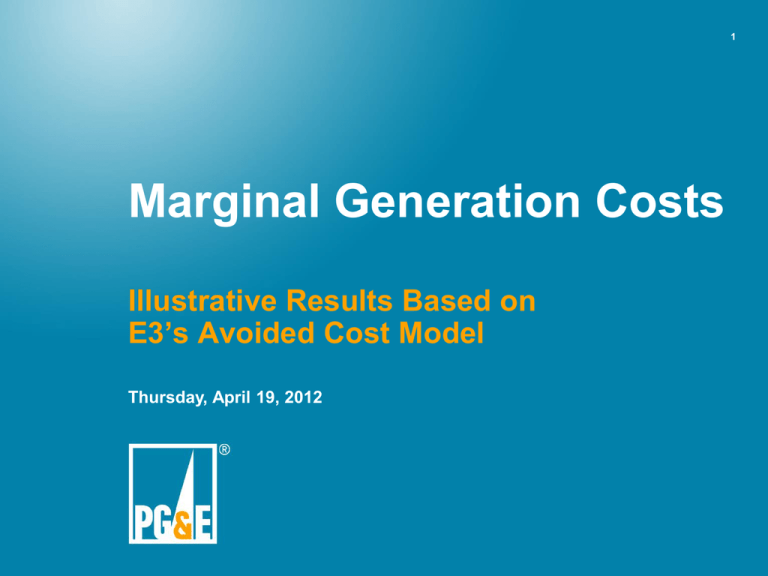Portfolio Modification
advertisement

1 Marginal Generation Costs Illustrative Results Based on E3’s Avoided Cost Model Thursday, April 19, 2012 2 Background PG&E's 2011 GRC Phase 2 settlement, D.11-12-053, adopted December Portfolio 15, 2011, calls for a workshop prior to May 1, 2012, to identify and Modification discuss publicly available models and data bases covering generation marginal costs. PG&E’s marginal generation costs are for retail rate design and allocating revenue requirements among PG&E’s bundled electric customer classes to reflect cost causation and promote economic efficiency. Marginal generation costs are estimates of the changes in PG&E’s electric procurement costs caused by small changes in customers’ energy usage and peak demand and do not reflect PG&E’s actual electric procurement costs. 3 Marginal Generation Costs Components Marginal Energy Cost (MEC) Portfolio Modification ¢/kWh. Average forecast hourly power price for northern California, January 1, 2014 through December 31, 2014. For five time of use (TOU) rate periods and three voltage levels. Marginal Generation Capacity Cost (MGCC) $/kW-year. Marginal generation resource’s residual capacity value—going-forward fixed costs minus market revenues—levelized over six year period, January 1, 2014 through December 31, 2019. For three voltage levels. 4 Public Source of Data and Calculation Avoided cost model created by Energy and Environmental Economics Portfolio Inc. (E3) for the CPUC. Modification In response to Administrative Law Judge Farrar’s October 5, 2011 “Administrative Law Judge’s Ruling on Updates and Adjustments to Energy Efficiency Avoided Cost Inputs and Methodology” in Rulemaking R.09-11-014. E3’s Distributed Electric Resources Avoided Cost Model, version 3.9: http://www.ethree.com/documents/E3%20Calculator%2009.20.11/DERAv oidedCostModel_v3.9_2011%20v4b%20CA%20Avg.zip 5 Marginal Cost Changes from 2011 GRC Phase 2 Data Source and Calculation Methodology 2011 GRC Phase 2 Methodology Based on E3 Methodology Modeling Portfolio Marginal Energy Cost Proprietary forward market price Public forward market price Modification (MEC): quotes and internal historical quotes and CAISO historical hourly price profile. hourly price profile from E3 Data Source Avoided Cost Model. Function Marginal Generation Capacity Cost (MGCC): Using an internal model with an existing combined cycle unit for 2011-2013 and a new combined cycle gas turbine for 2014 – Costing Methodology 2016. Using E3 Avoided Cost Model beginning in 2014 with shortterm capacity cost escalating up to long-run capacity cost in 2017-2018. 6 E3 Energy Price Forecast Methodology “For the period after the available forward market prices, the method interpolates between the last available NYMEX market price and the Portfolio Modification long-run energy market price.” “The long-run energy market price is used for the resource balance and all subsequent years.” “The annual long-run energy market price is set so that the [combined cycle gas turbine] CCGT’s energy market revenues plus the capacity market payment equal the fixed and variable costs of the CCGT...” “The long-run energy market price begins with the 2010 MRTU dayahead market price escalated by the natural gas burner tip forecast. “ 7 E3 Hourly Load Shape Methodology “…the annual energy avoided costs are converted to hourly values by multiplying the annual value by 8760 hourly market shapes.” Portfolio Modification “…the hourly shape is derived from day-ahead LMPs at loadaggregation points in northern and southern California obtained from the California ISO’s MRTU OASIS.” “…the hourly market prices are adjusted by the average daily gas price in California. The resulting hourly market heat rate curve is integrated into the avoided cost calculator, where, in combination with a monthly natural gas price forecast, it yields an hourly shape for wholesale market energy prices in California.” 8 Marginal Energy Cost (MEC) E3 2010 Price Ratios by Rate Period Relative to Summer Off-Peak Period TOU Rate Period Jan Feb Mar Apr May Jun Jul Aug Sep Oct Nov Dec 2010 Portfolio Modification 1.5 Summer Peak - - - - 1.1 1.3 1.7 1.6 1.6 1.4 Summer Partial-Peak - - - - 1.2 1.2 1.3 1.3 1.3 1.4 - - 1.3 Summer OffPeak - - - - 1.0 0.7 1.0 1.1 1.1 1.2 - - 1.0 Winter Partial-Peak 1.3 1.3 1.4 1.3 - - - - - - 1.3 1.2 1.3 Winter OffPeak 1.1 1.1 1.2 1.1 - - - - - - 1.1 1.0 1.1 Summer Off-Peak price = $42.85/MWh and Annual Average price = $49.49/MWh 9 Marginal Energy Cost (MEC) E3 2011 Updated Price Ratios by Rate Period Using Same Methodology TOU Rate Period Jan Feb Mar Apr May Jun Jul Aug Sep Oct Nov Dec 2011 Portfolio Modification 1.5 Summer Peak - - - - 1.1 1.4 1.7 1.8 1.7 1.6 Summer Partial-Peak - - - - 1.1 1.2 1.3 1.4 1.4 1.6 - - 1.3 Summer OffPeak - - - - 0.7 0.7 0.9 1.1 1.3 1.2 - - 1.0 Winter Partial-Peak 1.3 1.4 1.2 1.1 - - - - - - 1.5 1.5 1.3 Winter OffPeak 1.1 1.1 0.9 0.8 - - - - - - 1.3 1.3 1.1 Summer Off-Peak price = $42.30/MWh and Annual Average price = $49.49/MWh 10 E3 Hourly Price Shape Methodology Start with PG&E’s DLAP Day-ahead LMP from CAISO Portfolio Modification Divide by average of PG&E Citygate and Socal Border natural gas price from ICE. Calculate average using methodology from MPR model. Before averaging PG&E Citygate and Socal Border prices, each is increased for a) gas distribution rate, b) municipal rate surcharge, c) gas transportation escalation rate, and c) gas hedging transaction cost. The resulting hourly market heat rates are divided by the annual average market heat rate to generate an hourly price shape. 11 Marginal Energy Cost (MEC) For 2013 By Time of Use Rate Period and Voltage Level (¢/KWh) TOU Rate Period Transmission Multiplied MEC by (based on E3’s Primary 2014 hourly Distribution market price Energy Loss forecast) Factor Primary Distribution MEC Multiplied by Portfolio Modification Secondary Distribution Secondary Energy Distribution Loss Factor MEC Summer Peak 6.229 x 1.0188 = 6.346 x 1.0495 = 6.660 Summer Partial-Peak 5.493 x 1.0188 = 5.597 x 1.0495 = 5.874 Summer Off-Peak 4.285 x 1.0188 = 4.366 x 1.0495 = 4.582 Winter-Partial 5.472 x 1.0188 = 5.575 x 1.0495 = 5.851 Winter-Off 4.764 x 1.0188 = 4.853 x 1.0495 = 5.093 12 T&D Loss Factors Energy Loss Factors Percent Loss Energy Loss Factor Factor Cumulative Loss Factor Meter to Location From Source 1 / ( 1 - Percent Documents Loss Factor ) Portfolio Generation to Modification Generation Meter Product of Loss Inverse of Factors at each Cumulative Loss Level Factors Generator Bus Bar 0.000% 1.0000 1.0000 1.0000 Generation Tie 0.185% 1.0019 1.0019 0.9982 High Voltage Transmission 1.777% 1.0181 1.0200 0.9804 Low Voltage Transmission 1.544% 1.0157 1.0360 0.9653 Primary Distribution Output 1.847% 1.0188 1.0555 0.9474 Secondary Distribution 4.715% 1.0495 1.1077 0.9028 Sources: Transmission Losses from May 14, 2010 "Transmission Loss Factors" Distribution losses from "Distribution Loss Values for the TO-8 Filing" 13 E3 Capacity Price Forecast Methodology Resource Balance Year “…in the resource balance year and beyond, the value of capacity will equal the fixed cost of a new CT less the net revenues that the CT would Portfolio Modification attain from the selling to the real-time energy and ancillary service markets.” “…prior to resource balance, the capacity value is interpolated from the resource adequacy value of $28.07/kW-yr in 2008 to the residual capacity value in the resource balance year.” For example, the 2014 value of $101.91/kW-yr is calculated with the formula: $28.07 + (2014 – 2008) * ($138.83 - $28.07) / (2017 – 2008) “E3 has set the resource balance year [of 2017] to reflect the recent Joint IOU July 1, 2011 filing in the LTPP proceeding (R.10-05-006 track 1)…” The 2017 value is $138.83/kW-year. 14 E3 Capacity Price Forecast Methodology Energy Market Net Revenues, a.k.a. Gross Margin or Net Energy Benefit “In each hour that it operates, the unit earns the difference between the market price and its operating costs.” Portfolio Modification “To determine the long-run value of capacity, the avoided cost model performs an hourly dispatch of a new CT to determine energy market net revenues. The CT’s net margin is calculated assuming that the unit dispatches at full capacity in each hour that the real-time price exceeds its operating cost (the sum of fuel costs and variable O&M) plus a bid adder of 10%.” “The dispatch uses the 2010 MRTU real-time market shape (not the dayahead market shape), and adjusts for temperature performance degradation using average monthly 9am – 10pm temperatures…” 15 Combustion Turbine Cost In E3 Avoided Cost Model (2009$) Component Combustion Turbine (CT) Installed Cost Unit Amount Portfolio Modification $/kW $1,230.36 % 11.82% Annualized CT Installed Cost $/kW-year $145.42 Fixed O&M $/kW-year $17.40 Insurance $/kW-year $8.03 Property Tax $/kW-year $10.16 Full CT Proxy Cost $/kW-year $181.01 Effective Real Economic Carrying Charge Source: • E3 Avoided Cost Model, “CT Pro Forma" tab, cells J4:L12 and • California Energy Commission Staff 2009 Final Report: “Comparative Cost of California Central Station Electricity Generation Technologies” CEC-200-2009-017-SD • 2009 Market Price Referent resolution: E 4298 16 Residual Capacity Value In Resource Balance Year (2017$) Component Full Combustion Turbine Proxy Cost (2009$) Unit Amount $/kW-year $181.01 multiplier Portfolio Modification 1.17 Full Combustion Turbine Proxy Cost (2017$) $/kW-year $212.08 Operating Cost $/kW-year $37.17 Real-Time Dispatch Revenue $/kW-year ($113.88) Ancillary Services Revenue $/kW-year ($8.65) Subtotal Residual Capacity Value $/kW-year $126.73 % 92.6% $/kW-year $138.83 Escalation, 2% per year, 2009 to 2017 Percentage Adjustment for Temperature-caused Degradation of Heat Rate Efficiency Residual Capacity Value Source: E3 Avoided Cost Model, "Market Dynamics" tab, cells K188:K194 17 Marginal Generation Capacity Cost (MGCC) Calculation of Levelized Cost over 2013-2018 ($/kW-year) Year Residual Capacity Value 2014 $101.91 2015 $114.22 2016 $126.52 2017 $138.83 2018 $140.42 2019 $142.09 PG&E After-tax Weighted Average Cost of Capital Net Present Value of six year sum MGCC, Levelized Cost for 6 years at 7.6% 7.6% $587.41 $125.53 Source: E3 Avoided Cost Model, "Market Dynamics" tab, columns G through L, row 199 Portfolio Modification 18 Marginal Generation Capacity Cost (MGCC) Levelized For 2014-2019 By Voltage Level ($/KW-year) Period 2014-2019 Levelized Cost Transmission Multiplied MGCC by (based on E3’s Primary 2014-2019 Distribution capacity Demand forecast) Loss Factor $125.53 x 1.0294 = Primary Distribution MGCC $129.21 Multiplied by Portfolio Modification Secondary Distribution Secondary Demand Distribution Loss Factor MGCC x 1.0599 = $136.95 19 T&D Loss Factors Demand Loss Factors Percent Loss Demand Loss Factor Factor Cumulative Loss Factor Meter to Location From Source 1 / ( 1 - Percent Documents Loss Factor ) Portfolio Generation to Modification Generation Meter Product of Loss Inverse of Factors at each Cumulative Loss Level Factors Generator Bus Bar 0.000% 1.0000 1.0000 1.0000 Generation Tie 0.211% 1.0021 1.0021 0.9979 High Voltage Transmission 2.061% 1.0210 1.0232 0.9773 Low Voltage Transmission 1.946% 1.0198 1.0435 0.9583 Primary Distribution Output 2.852% 1.0294 1.0741 0.9310 Secondary Distribution 5.651% 1.0599 1.1385 0.8784 Sources: Transmission Losses from May 14, 2010 "Transmission Loss Factors" Distribution losses from "Distribution Loss Values for the TO-8 Filing" 20 TOU Rate Periods and Voltage Levels Summer is from May 1 through October 31 and Winter is from November 1 through April 30. The summer peak period is from noon to 6:00 p.m., Monday through Friday, except holidays; the summer partial-peak period is from 8:30 a.m. to noon and 6:00 p.m. to 9:30 p.m., Monday through Friday, except holidays; and, the summer off-peak period is 9:30 p.m. to Portfolio 8:30 a.m., Monday through Friday, except holidays, andModification all day Saturday, Sunday and holidays. The winter partial-peak period is from 8:30 am to 9:30 p.m., Monday through Friday, except holidays; and, the winter off-peak period is 9:30 p.m. to 8:30 a.m., Monday through Friday, except holidays, and all day Saturday, Sunday and holidays. Holidays for rate making purposes are the legally observed dates for New Year’s Day, President’s Day, Memorial Day, Independence Day, Labor Day, Veterans Day, Thanksgiving Day and Christmas Day. The three voltage levels are transmission (60 kilovolt (kV) and above); primary distribution (between 4 kV and 50 kV); and, secondary distribution (below 4 kV).









